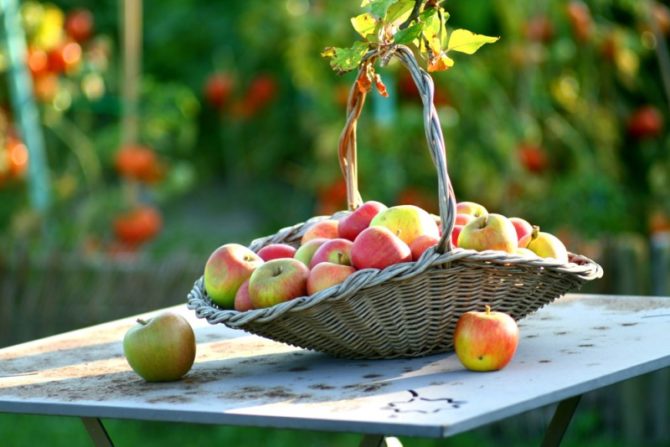Autumn Leaves and Apples
Fall, glorious fall. Memories of summer’s corn, eaten in abundance on my visit to the US, are distant as I peruse the tender root vegetables, leafy Swiss chard, bitter-crisp lettuces of autumn. It is endlessly fascinating how exciting each season can be, since they are always basically the same. Each October it’s grapes and roots; each April it’s radishes and strawberries; each July it’s nectarines and peaches. But seasonal foods are like friends, really. We love to keep the same ones, and look forward with delight to seeing them each and every time, even though we know their quirks, their jokes, their habits, their laughter.
I often say that autumn is my favorite time to cook, and in truth it is. I think it may have less to do with the actual ingredients than it does with the cozy wrap of my home, my hearth, and the flickering candles I set on the table each night. In Normandy, autumn brings with it the most glorious of days, some of them hot enough to merit that little summer frock I pulled out in July. But mornings snap with chill, and the evening light disappears earlier and earlier, making the cocoon of home a glorious thing.
And out come those warming recipes. I’m a bit of a disappointment as a cook if one expects a good Daube de Boeuf or Boeuf Bourguignon from my stove, as stews don’t thrill my culinary spirit. Instead, I’m tempted to slow-cook an oxtail with onions, cinnamon sticks, carrots and a splash—just a splash—of wine from the Languedoc, or stuff a hanger steak with walnuts and Roquefort and roast it just until it’s crisp on the outside. Autumn means braised lamb shanks, too, or succulent, slow-cooked pork cheeks seasoned with garden herbs like bay leaf and rosemary, the final sprouts of basil and a furry sage leaf or two. Just thinking about these flavors makes me hunger for them.
Arguably, though, it’s the fruits and vegetables of autumn that make my heart sing. Once those muscat grapes are in full season I realize how much I’ve missed them. Even the simple apple (I won’t touch one until I see them ready on my own trees) tastes like the best thing on earth when it’s got that autumn crackle to it. As autumn proceeds it ushers in torpedo-shaped endive, which I eat raw nearly every day, unless I’m braising or grilling it; celery root which, when steamed, turns sweet and nutty; and humble potatoes—it is finally time to mash them, top them with butter and garden parsley, fry them with newly smoked bacon, bake them with cream into a crisp-topped gratin.
There is cauliflower, too, which I include in the same under-appreciated vegetable category as Brussels sprouts, turnips and rutabagas, because they all elicit a nose-wrinkle more often than not. What surprise cauliflower offers, though. One day I may be awarded a gold medal by the cauliflower producers of the world, for my grated cauliflower and garlic sauté. It has won over even the most skeptical.
Swiss chard is the graceful lady of autumn, offering two-for-one. The pure white stem turns translucent when sautéed with shallots and herbs, and it tastes like a delicate artichoke; her leaves are more sultry, and I love to slice them thin and sautée/braise them with a touch of hot pepper and garlic. That isn’t a very French preparation I’ll admit, but then some days I’m not very French, either!
Back to the apple, which to me is both fruit and vegetable. We’ve got such an abundance of sweet/tart/slightly bitter varieties that are so multidimensional I offer a weeklong cooking class centered entirely around them. Yes, we prepare plenty of other foods, but the apple is the star. I love the looks of surprised enchantment at the dishes we make, from the delicately salty apple chips that we nibble along with sparkling apple cider to lightly spiced, candied wedges served alongside roast guinea fowl.
Typical to autumn in Normandy is boudin noir, or blood sausage, which is always served with sautéed apples cooked long enough to caramelize. It is indescribably delicious, and I use that word “indescribable” with great deliberation. One cannot describe blood sausage and make people hungry—it’s something that must be dared, and apples help ease the dare. Boudin blanc, the black version’s more delicate cousin, made with chicken and cream, is another cool weather treat, also served with apple.
I fill apples with leeks and cream and bake them in the oven for a first course; I turn them into a savory cake with rosemary; I cook them slowly with a drop of water and use the sauce under a fat, golden pork chop.
If the apple is part of the first or the main course, it is absent from dessert. Otherwise, it shines at the end of a meal in the guise of a Tarte Tatin. My favorite apple for this is the tart little Cox Orange Pippin, which turns to perfume when it is cooked with sugar and butter and tucked into pâte brisée. It must be tasted to be believed.
I do individual tarts, too, slicing the apples nearly paper thin and layering them on a round of pastry. I bake them until pastry and apples are crisp, then drizzle the tarts with lavender honey as soon as they’re out of the oven, and heaven is on the plate.
The Comice pear is another autumn treasure. Those I buy from Vincent Prieur, who grows them in his orchards not far from where I live, are more than magical. Fat, so juicy they make a good ripe peach seem dry, their flavor is elegantly floral. I honestly cannot bear to defile this pear with heat, so we eat them raw, by the kilo.
And then there are the muscat grapes. Now these aren’t produced in Normandy—they come from Provence and its neighboring regions, which is local enough for me. Their skin has a pleasant bit of tannin, their flesh is pure essence of grape, and once I’ve begun to pop them between my teeth, it is hard to quit. I eat them all day long, I fold them into a cream custard, a cake batter, add them to a tart, use them with onions in a sort of chutney. Yes, they must be relieved of their seeds, a job I do in lieu of meditation. The results are worth the trouble.
So, you see, this riff on seasonality never ends! And while I say the seasons are always the same, that statement has no real meaning. The grapes of last year aren’t the same as those of this season, nor am I the same. What I do with the season’s bounty depends on what subtle flavor the bounty offers and what new ideas I’ve gleaned. That all changes with a constancy that surprises.
Cooks, chefs, eaters…we change, we share our insights, we enjoy the pleasures of each season’s table, as we do this autumn again.
FRESH GRAPE CUSTARD (FONDANT NORMAND AUX RAISINS)
Normally, Fondant Normand is made with apples. This is a sprightly autumn variation that takes wonderful advantage of the custard and the full flavor of honeyed Muscat grapes.
3 tbsp unsalted butter, at room temperature
2 lb (1 kg) flavorful fresh grapes, such as Muscat, seeded if necessary
2 tbsp cognac or other fruit liqueur
For the vanilla sugar:
1 vanilla bean, split lengthwise
1 cup granulated sugar
For the custard:
6 tbsp vanilla sugar
2 tbsp unsalted butter, at room temperature
2 large eggs
¾ cup (185 ml) milk
¾ cup (100 g) unbleached all-purpose flour
1 tsp baking powder
For the topping:
1/3 cup (65 g) vanilla sugar
4 tbsp (½ stick; 60g) unsalted butter, at room temperature
1 large egg
1. At least two days before making custard, make vanilla sugar: in a tightly-covered container, bury the split vanilla bean in the sugar. Not all the sugar is needed for this recipe; it keeps indefinitely.
2. Preheat oven to 400°F (205°C). Thoroughly butter and flour a 12 ½ x 7 ½-inch (32 x 19 cm) baking pan or 2-quart (2 l) round baking dish about 4 inches (10 cm) deep.
3. Melt butter in a medium-sized skillet over medium heat. Add grapes and sauté just until they are hot through, about 4 min. Remove from heat and add cognac, swirling it in the pan. If cognac doesn’t flame up, light it with a match, standing well back and averting your face. Reserve the grapes.
4. Prepare the custard: In a large bowl, mix together vanilla sugar and butter until combined. Add eggs and whisk until thoroughly incorporated. Whisk in milk, then sift flour and baking powder over the mixture, and whisk until the mixture is smooth and pale. Fold in grapes with their cooking juices and pour into prepared pan. Bake in center of oven until puffed and golden, 30 min.
5. While custard is baking, prepare topping: Mix together vanilla sugar and butter, then whisk in egg until thoroughly combined. Remove baked custard from oven and spread topping over it. Return custard to oven and bake until golden and bubbling, an additional 20 min. Cool to room temperature before serving.
Susan Herrmann Loomis teaches cooking classes in Normandy and Paris, and she is a prolific author. Susan’s website
From the France Today Archives
Share to: Facebook Twitter LinkedIn Email





